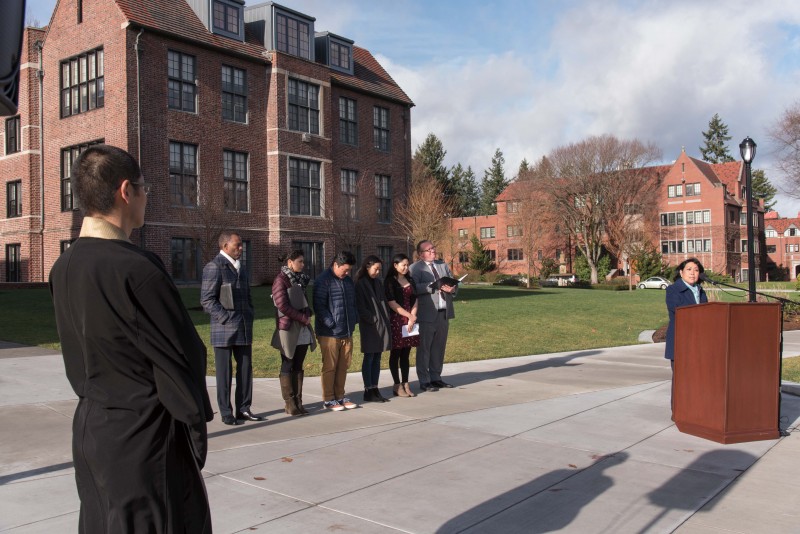Click photos for captions.
Remembering history
On Saturday morning, Oct. 7, campus members and alumni attended a groundbreaking ceremony for five new cherry saplings that would replace the 28-year-old trees that had reached the end of their lifespans.
The cherry trees were originally planted in 1940 as a gift from the Japanese Student Club. Each new generation of trees stands in remembrance of Puget Sound’s 36 Japanese American students who were sent to internment camps in 1942.
It was a blustery day of broken sunshine as the quiet group gathered at the east end of Howarth Hall. The giant sequoia tree and the onlookers’ long shadows leaned toward the five white stakes in the grass marking the cherry trees’ new home-to-be.
“We gather to remember our history and to prepare for the next chapter in this story,” said Chaplain Dave Wright ’96. “We are here to recognize and honor the heritage of one of the most painful and awful moments of our campus and national history.”
Five students from the university’s Asian American Pacific Islander Collective and Asian Student Community clubs stood silently as he spoke, then picked up five thick golden cores of wood, sawn from the trunks of the old cherry trees, and placed them against the white markers. The Rev. Karen Yokota-Love offered a blessing.
Later in the fall, once the new cherry saplings went dormant, they were planted, and the wood cores of their predecessors were buried at their roots—a symbol of the passing of life from generation to generation.
The students who gave the original cherry trees in 1940 could not have known just how fitting the gesture was. Fitting, and sadly ironic, says Jan Leuchtenberger, director of the Asian Studies Program.
“It is in the cultural and aesthetic history of Japan that cherry blossoms bloom gloriously in the spring, and then the blossoms are gone in a week or two,” she explains. “All of nature, and especially the cherry trees, are held up to evoke the Buddhist idea that there is beauty in that impermanence, and it is much more beautiful for the fact that they will die.”
She adds, “It is a dilemma and a conundrum, [for] humanity cannot help but grow attached to things—to beauty and to life.” The students were to experience this loss— they and many others lost three years of their lives to the camps.
“They were purposely sent to these really desolate places; it was just horrible,” says Andrew Gomez, assistant professor of history. “It was robbing people of their livelihood, their dignity, and putting them in poor conditions. And they were citizens. That’s what makes it so flagrant.”
Andrew notes that each spring, small signs naming the lost students are placed below the cherry trees.
“Aesthetically, it’s a beautiful gesture,” he says. “What we have to ask ourselves every year is, ‘Are we undertaking policies and practices that ensure that this doesn’t happen again?’ If it is a reminder of the failings of the country and the institution, and what we can do to fix it, to be better, then it’s a good thing.”
In 2009, Puget Sound awarded all 36 of its lost Japanese American students the degree Bachelor of Arts, Honoris Causa, nunc pro tunc (meaning “now for then”). Six of those former students or a family member made it to Commencement to accept the diploma in person.
Then they stood on the stage for a photo, two in graduation robes, two leaning on canes. It was May, a hazy blue day, and the cherry trees had passed their full bloom and were clinging to the last of their pink blossoms.
Shirley Skeel
<












